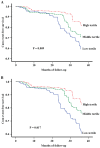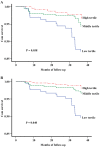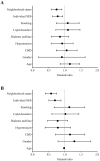The influence of individual socioeconomic status on the clinical outcomes in ischemic stroke patients with different neighborhood status in Shanghai, China
- PMID: 28138313
- PMCID: PMC5278663
- DOI: 10.7150/ijms.17241
The influence of individual socioeconomic status on the clinical outcomes in ischemic stroke patients with different neighborhood status in Shanghai, China
Abstract
Objective: Socioeconomic status (SES) is being recognized as an important factor in both social and medical problems. The aim of present study is to examine the relationship between SES and ischemic stroke and investigate whether SES is a predictor of clinical outcomes among patients with different neighborhood status from Shanghai, China. Methods: A total of 471 first-ever ischemic stroke patients aged 18-80 years were enrolled in this retrospective study. The personal SES of each patient was evaluated using a summed score derived from his or her educational level, household income, occupation, and medical reimbursement rate. Clinical adverse events and all-cause mortality were analyzed to determine whether SES was a prognostic factor, its prognostic impact was then assessed based on different neighborhood status using multivariable Cox proportional hazard models after adjusting for other covariates. Results: The individual SES showed a significant positive correlation with neighborhood status (r = 0.370; P < 0.001). The incidence of clinical adverse events and mortality were significantly higher in low SES patients compared with middle and high SES patients (P = 0.001 and P = 0.037, respectively). After adjusting other risk factors and neighborhood status, Kaplan-Meier analysis showed clinical adverse events and deaths were still higher in the low SES patients (all P < 0.05). Multivariate Cox regression analysis demonstrated that both personal SES and neighborhood status are independent prognostic factors for ischemic stroke (all P < 0.05). Besides, among patients with low and middle neighborhood status, lower individual SES was significantly associated with clinical adverse events and mortality (all P < 0.05). Conclusion: Both individual SES and neighborhood status are significantly associated with the prognosis after ischemic stroke. A lower personal SES as well as poorer neighborhood status may significantly increase risk for adverse clinical outcomes among ischemic stroke patients.
Keywords: China; Health inequality; Ischemic stroke; Neighborhood status; Socioeconomic status; Survival..
Conflict of interest statement
The authors have declared that no competing interest exists.
Figures




Similar articles
-
The effect of socioeconomic status on three-year mortality after first-ever ischemic stroke in Nanjing, China.BMC Public Health. 2006 Sep 11;6:227. doi: 10.1186/1471-2458-6-227. BMC Public Health. 2006. PMID: 16961936 Free PMC article.
-
Low socioeconomic status increases short-term mortality of acute myocardial infarction despite universal health coverage.Int J Cardiol. 2014 Mar 1;172(1):82-7. doi: 10.1016/j.ijcard.2013.12.082. Epub 2014 Jan 7. Int J Cardiol. 2014. PMID: 24444479
-
Neighborhood and individual socioeconomic determinants of hospitalization.Am J Prev Med. 2006 Aug;31(2):127-34. doi: 10.1016/j.amepre.2006.03.025. Epub 2006 Jun 16. Am J Prev Med. 2006. PMID: 16829329
-
Neighborhood Socioeconomic Status and Stroke Incidence: A Systematic Review.Neurology. 2021 May 11;96(19):897-907. doi: 10.1212/WNL.0000000000011892. Epub 2021 Mar 25. Neurology. 2021. PMID: 33766995 Free PMC article.
-
Socioeconomic Status and Stroke: A Review of the Latest Evidence on Inequalities and Their Drivers.Stroke. 2025 Mar;56(3):794-805. doi: 10.1161/STROKEAHA.124.049474. Epub 2024 Dec 19. Stroke. 2025. PMID: 39697175 Review.
Cited by
-
Does socioeconomic position affect knowledge of the risk factors and warning signs of stroke in the WHO European region? A systematic literature review.BMC Public Health. 2020 Sep 29;20(1):1473. doi: 10.1186/s12889-020-09580-x. BMC Public Health. 2020. PMID: 32993624 Free PMC article.
-
Role of cognitive reserve in ischemic stroke prognosis: A systematic review.Front Neurol. 2023 Feb 22;14:1100469. doi: 10.3389/fneur.2023.1100469. eCollection 2023. Front Neurol. 2023. PMID: 36908598 Free PMC article.
-
Hospital Variation in 30-Day Mortality for Patients With Stroke; The Impact of Individual and Municipal Socio-Demographic Status.J Am Heart Assoc. 2019 Jul 16;8(14):e010148. doi: 10.1161/JAHA.118.010148. Epub 2019 Jul 15. J Am Heart Assoc. 2019. PMID: 31306031 Free PMC article.
-
Ethnic and Gender Variations in Ischemic Stroke Patterns among Arab Populations in Northern Israel: A Preliminary Exploration towards Culturally Aware Personalized Stroke Care.J Pers Med. 2024 May 15;14(5):526. doi: 10.3390/jpm14050526. J Pers Med. 2024. PMID: 38793108 Free PMC article.
-
Socioeconomic status predicts the risk of stroke death: A systematic review and meta-analysis.Prev Med Rep. 2020 May 15;19:101124. doi: 10.1016/j.pmedr.2020.101124. eCollection 2020 Sep. Prev Med Rep. 2020. PMID: 32509509 Free PMC article. Review.
References
-
- Wu Z, Yao C, Zhao D. et al. Sino-MONICA Project: a collaborative study on trends and determinants in cardiovascular diseases in China, Part I: morbidity and mortality monitoring. Circulation. 2001;103:462–8. - PubMed
-
- Jakovljevic D, Sarti C, Sivenius J. et al. Socioeconomic status and ischemic stroke: the FINMONICA Stroke Register. Stroke. 2001;32:1492–8. - PubMed
-
- Clark AM, DesMeules M, Luo W. et al. Socioeconomic status and cardiovascular disease: risks and implications for care. Nat Rev Cardiol. 2009;6:712–22. - PubMed
MeSH terms
LinkOut - more resources
Full Text Sources
Other Literature Sources
Medical

